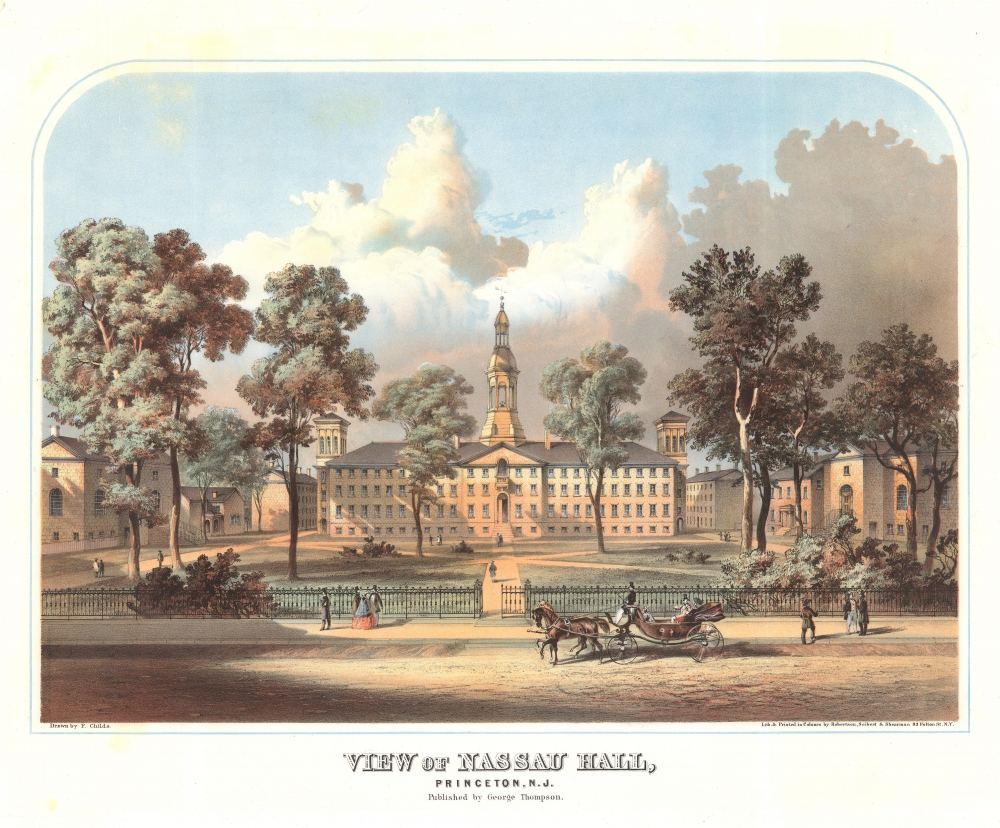Digital Image: 1860 Childs Chromolithograph View of Nassau Hall, Princeton University
ViewNassauHall-childs-1860_d
Title
1860 (undated) 16 x 20 in (40.64 x 50.8 cm)
Description
FOR THE ORIGINAL ANTIQUE MAP, WITH HISTORICAL ANALYSIS, CLICK HERE.
Digital Map Information
Geographicus maintains an archive of high-resolution rare map scans. We scan our maps at 300 DPI or higher, with newer images being 600 DPI, (either TIFF or JPEG, depending on when the scan was done) which is most cases in suitable for enlargement and printing.
Delivery
Once you purchase our digital scan service, you will receive a download link via email - usually within seconds. Digital orders are delivered as ZIP files, an industry standard file compression protocol that any computer should be able to unpack. Some of our files are very large, and can take some time to download. Most files are saved into your computer's 'Downloads' folder. All delivery is electronic. No physical product is shipped.
Credit and Scope of Use
You can use your digial image any way you want! Our digital images are unrestricted by copyright and can be used, modified, and published freely. The textual description that accompanies the original antique map is not included in the sale of digital images and remains protected by copyright. That said, we put significant care and effort into scanning and editing these maps, and we’d appreciate a credit when possible. Should you wish to credit us, please use the following credit line:
Courtesy of Geographicus Rare Antique Maps (https://www.geographicus.com).
How Large Can I Print?
In general, at 300 DPI, you should at least be able to double the size of the actual image, more so with our 600 DPI images. So, if the original was 10 x 12 inches, you can print at 20 x 24 inches, without quality loss. If your display requirements can accommodate some loss in image quality, you can make it even larger. That being said, no quality of scan will allow you to blow up at 10 x 12 inch map to wall size without significant quality loss. For more information, it is best consult a printer or reprographics specialist.
Refunds
If the high resolution image you ordered is unavailable, we will fully refund your purchase. Otherwise, digital images scans are a service, not a tangible product, and cannot be returned or refunded once the download link is used.
Cartographer
Henry Seibert (May 17, 1833 - c. 1902) was a German-American lithographer, financier, and businessman. Born in Lauterbach in the Grand Duchy of Hesse to John and Magdalena Seibert. One of seven children (six sons and a daughter), Henry's father John Seibert was a locksmith and machinist by trade and a man of good practical education. John Seibert, believing that a new life in America would afford his growing family with greater advantages than were available to them in Europe, moved the family to Newburgh, New York in 1837 and, in 1845, relocated to Brooklyn. John Seibert died in 1855. Henry, having immigrated to the United States at the age of 4, was educated in Brooklyn public schools and then learned lithography. He formed the lithography firm of Robertson and Seibert in 1852 with Alexander Robertson, which they built into a successful enterprise. James A. Shearman joined the firm in 1859, creating Robertson, Seibert and Shearman, which lasted for approximately a year, but created numerous beautiful chromolithograph views. When both Robertson and Shearman withdrew from the partnership in 1860, Seibert formed the firm Seibert, Wetzler and Company with this brother Jacob and Ernest Wetzler. The following year the partnership changed to Henry Seibert and Brothers and included Henry, Jacob, and Charles Seibert. The Seibert brothers acquired the lithographic firm of Ferdinand Mayer in the early 1870s and continued to operate it as a separate establishment managed by Jacob Lowenhaupt. Jacob Seibert left to open his own firm in 1878, which means Henry and Charles carried on their business under the imprint Seibert and Brother. Henry Seibert essentially retired from the firm in 1880, although he maintained a financial interest. After retiring, Seibert began to associate himself with other business and financial enterprises, gaining a reputation as a careful and sagacious associate and often operating as both a promoter and a directing manager. He became deeply involved in railroad interests, including the Chicago and Eastern Illinois Railroad, the Queens County and Suburban Railroad, the Brooklyn Union Elevated Railroad, the Brooklyn Heights Railroad, and the Brooklyn Rapid Transit Company. He also served, at one time or another, as director of the Mollenhauer Sugar Refining Company, the Nassau Trust Company, the Lanyon Zinc Company, and the Manhattan Brass Company. He also served as director and vice-president of the Minnesota Iron Company during his lifetime. In 1892, New York Governor Flowers appointed Seibert as a commissioner from the state of New York to the Columbian Exposition in Chicago in 1892. Seibert married Emma J. Bergman with whom he had three sons and a daughter. More by this mapmaker...

